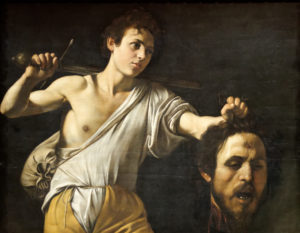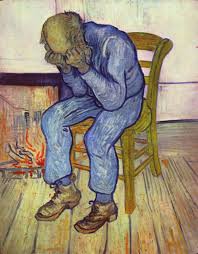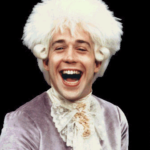Ser un artista: la nueva marca de locura – Charlotte Heley (and translators)
Ser un artista: la nueva marca de locura.
¿Cuál es la definición de ser un artista? Algunas palabras incluyen ‘genio’, ‘maestro’ y ‘experto’. Sin embargo, otras incluyen ‘perturbado’, ‘trastornado e ‘inestable’. Los artistas más famosos del mundo, como Caravaggio, Gentileschi y Van Gogh, todos vienen con las historias trágicas. Así que, ¿solo es posible ser un artista si estás loco? Voy a analizar algunas pinturas de estos artistas famosos y examinar si ellos podrían haber pintado estas obras maestras sin sus pasados problemáticos.
En primer lugar, hay Michelangelo Merisi da Caravaggio (1571-1610), un artista italiano que fue acusado de asesinato y como resultado le desterraron de Roma. Podemos ver su angustia a través de su obra que se llama ‘David con la cabeza de Goliat’ (1610). Representa el momento exacto en que David vuelve de matar al filisteo y presenta la cabeza a Abner. Algunos historiadores del arte dicen que la cabeza de Goliat es un autorretrato de Caravaggio. Puede representar que se sintiera culpable o avergonzado por sus acciones, así que pintó esta obra para mostrar su remordimiento. Hoy en día, no obstante, Caravaggio es considerado uno de los padres de la pintura moderna. Pero sin su delito, ¿habría tenido la misma materia perturbadora para pintar?

De otra manera igualmente angustiosa, las obras de Artemisia Gentileschi (1593-1653) también pueden ser vistas como una visión de su vida. Su cuadro ‘Susana y los mayores’ (1610) expresa la historia bíblica de Susana, una joven virtuosa, que está siendo acosada sexualmente por los mayores. Gentileschi representa a Susana como vulnerable, los hombres están situados por encima de ella para simbolizar la dominación patriarcal que existía durante de su época. Su odio evidente hacia los hombres podría haber venido del hecho que, a la edad de 17, Gentileschi fue violada. Usa colores vibrantes quizás porque el suceso todavía estaba fuerte en su memoria. Hoy en día, ella está considerada como la artista más progresiva de su generación. Pero sin este suceso grave, ¿habría tenido la misma razón para pintar?
Por fin, está Vincent Van Gogh (1853-1890), un artista ligeramente más moderno. Podemos suponer que su vida era trágica y estaba llena de problemas, a través de una de sus obras, ‘En la puerta de la eternidad’ (1890). La completó en el último año de su vida, así que quizás pueda ser él mismo; dado que el título sugiere que el hombre está cerca del final de su vida. La manera en que se sienta el hombre del cuadro, expone la manifestación física de la desesperación – usando sus manos para cubrir su rostro. La falta de esperanza que Van Gogh muestra en este cuadro podría representar el hecho que Van Gogh sufría de depresión grave durante toda su vida. De hecho, en su último año – el mismo año que la pintura fue pintada – llevó una pistola a su trabajo y se mató. Sin embargo, hoy en día está considerado por mucha gente el mejor pintor holandés, después de Rembrandt. Pero sin su depresión ¿habría sido capaz de pintar con la misma pasión?
En resumen, a menudo parece que las obras de los artistas mundialmente famosos vienen de eventos o problemas traumáticos en sus vidas y después del análisis podemos ver sus problemas a través de sus pinturas. Estos sucesos son los que los definieron y los dibujaron como su materia inmediata. Sin estos sucesos, que los tildan como “locos”, probablemente no habrían podido crear estas obras maestras. Por lo tanto, en cierto sentido, se podría decir que sus sufrimientos han hecho el mundo del arte más rico y han sumado un nuevo significado a lo que realmente significa ser un artista.
Translation
Year 12 students of Spanish
Polly Chiddicks, Natasha Scott, Alex Bradley and Alois Pachner
What is the definition of being an artist? Some words include genius, master and expert. However, others include disturbed, tormented and unstable. The most famous artists in the world, like Caravaggio, Gentileschi and Van Gogh, all come with tragic stories. Therefore, is it only possible to be an artist if you are crazy? I am going to analyse some paintings by these famous artists and examine if they could have painted these masterpieces without their past difficulties.
Firstly, there is Michelangelo Merisi da Caravaggio (1571-1610), an Italian artist who was accused of murder and as a result was banished from Rome. We can see his anguish through his painting called “David with Goliat’s head” (1610). It represents the exact moment when David is back from killing the Philistine and presents the head to Abner. Some art historians say that Goliat’s head is a portrait of Caravaggio itself. It could represent that he was guilty or ashamed because of his actions, so he painted this work to show his remorse. Nowadays, however, Caravaggio is considered one of the fathers of modern painting. But would he have had the same disturbing matter for painting without his crime?
On the other hand, but in an equally anguished manner, the works of Artemisia Gentileschi (1593 – 1653) can also be seen as a reflection of her life. Her painting “Susana and the Elders” (1610) shows the biblical story of Susana, a virtuous youth who was sexually assaulted by elders. Gentileschi depicts Susana as vulnerable with the men located on top of her to symbolise the patriarchal dominance that existed during her time. Her evident hatred of men could have come from the fact that, at the age of 17, Gentileschi was violated. She uses vibrant colours, perhaps because the event had left such a strong mark in her memory. Presently, she is considered to be the most progressive artist of her time. But without this awful experience, would she have had the same passion for painting?”

Finally, there is Vincent Van Gogh (1853-1890), a slightly more modern artist. We can suppose that his life was tragic and it was full of problems, through one of his works, ‘At Eternity’s Gate’ (1890). He completed it in the final year of his life, therefore perhaps Van Gogh could be the same; because the title suggests that the man is close to the end of his life. The way in which the man of the painting is sitting, explains the physical appearance of desperation – using his hands to conceal his face. The lack of hope that Van Gogh shows in this painting could represent the fact that Van Gogh suffered from serious depression all of his life. In fact, in his final year – the same year that the painting was painted – he took a gun to his work and he killed himself. However, today he is considered by many people to be the greater Dutch painter, after Rembrandt. But without his depression, would he have been capable of painting with the same passion?
In summary, it often seems that the works of the globally famous artist come from events or traumatic problems in their lives and after the analysis we can see their problems through their paintings. It is these events that define them and they painted them as their immediate subject matter. Without these events, that brand them as crazy, they probably wouldn’t have been able to create these masterpieces.















Post Comment
You must be logged in to post a comment.